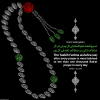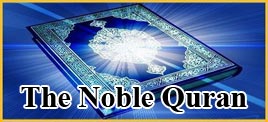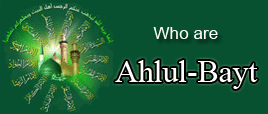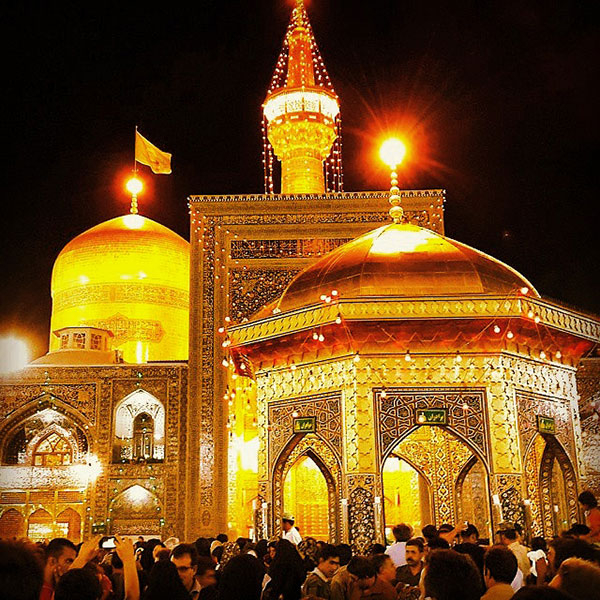Hazrat Imam Mahdi (aj) is the twelfth and last of the chain of the Purified Imams (as) and the divine successors. He was born at the time of dawn, on Friday the 15th of Shaban 255 A.H. in the city of Samarrah1.
His respected father is Imam Hasan al-Askari (as). His beloved mother is Janab al-Nargis Khatoon (ra). She was the descendant of the Caesar of Rome from her father's side and from her mother's side she had descended from shamoon the vicegerant of Hazrat Isa (as).2
This exalted personality has the same name and kunniyat (agnomen) as the Holy Prophet (S). His titles are Mahdi, Hujjat, Qaem, Montazer, Sahibuzzaman and Khalaf al-saleh. His most famous honourific however is Al-Mahdi (aj).3
Ibn Khallikaan writes; "His well-known title is Hujjat. The shias know him by the titles, Montazar, Qaem and Mahdi"4
The great scholar Mohaddith al-Noori has collected 182 titles of Imam Mahdi (aj) from the Islamic texts. Each of these titles signify each of his virtuous qualities.5
The tyrant Abbasid rulers were aware of the prophecies of the Holy Prophet (S). That the son of Imam Hasan al-Askari (as) by the name of Mahdi will appear to remove all kinds of corruption and tyranny; hence they planned to eliminate the child when he is bom. Due to this the birth of Imam Mahdi (aj) was kept a secret like that of Hazrat Ibrahim (as). So much so that except for the most trusted of the shias and his own family, no one knew of the existence of Hazrat (as). In spite of this whenever there was an opportunity, Imam Hasan al-Askari (as) showed his son to his trustworthy followers; that in future they may follow him. This was in order that the shias may remain firm upon the right path, and not be led astray. A servant Abu Ghanim says:
"Abu Muhammad (as) has a son whose name is Muhammad." On the third day of his birth he brought him before his companions and said:
"After me he is your Master of the affair, he is my successor, he is the same 'Qaem', who is awaited by alt When the earth will be fraught with injustice and oppression then he will reappear and fill the earth with justice and righteousness."6
The early years of his life were spent in the usual way. When he was in his fifth year, he lost his respected father.7
After this tragic event the responsibility of guiding the shias was transferred upon him. At this time, Hazrat (as) possessed all the qualities and the divine knowledge that was bestowed upon the previous Imams (as), by the Almighty. In the same way as Hazrat Yahya (as) in his childhood and Hazrat Isa (as) in his infancy was favoured with the divine office of Prophethood by Allah.8
Although all the Imams (as) were holding the divine office of wilayat, the efforts of the enemies to eliminate the twelfth Imam (as) were maximum. Hence Imam az-Zaman (as) was entrusted to ghaibat and being away from the sight of people, he had to fulfill all the duties of an Imam.
It is said that the concealed life of Hazrat Mahdi (aj) is not something extraordinary. Rather, in the life of so many Prophets (as) and even Imams (as) it is seen, that they were at some time, in concealment from the people. The Holy Quran records the concealment of various prophets (as) like Hazrat Ibrahim (as)9, Hazrat Musa (as)10 and Hazrat Isa (as)11.
The Holy Prophet (S) and the Imams (as) had pointed out to the people the imminent occultation of their last proof (Imam Mahdi-aj), so that no doubt or misunderstanding should remain, regarding this problem.
The occultation (Ghaibat) of the twelfth Imam consists of two phases: one is Ghaibat al-Sughra (The lesser occultation) and the second is Ghaibat al-Kubra (The greater occultation). Imam Ja’far as Sadiq (as) said:
'There are two occultations for Qaem. One is short and the other prolonged. In the short occultation only the special shias will know of his whereabouts. And in the longer occultation only his trustworthy servants will know where he is"12
According to the well-known reports, the lesser occultation (ghaibat al-sugra) commenced from the year of his Imamat in 260 A.H and continued for 69 years. Some of the scholars like Shaykh Mufeed and Syed Mohsin Amin Amili maintain that ghaibat al-sugra began right from the time of his birth.13
Because, even in those early years, Hazrat (aj) was concealed from the common people. According to this method, the period of ghaibat al-sugra comes to seventy four years.
During the period of ghaibat al-sugra. Imam Mahdi (aj) himself appointed his deputies from among the righteous shias. Four of them succeeded each other and continued to fulfill the duty of intermediaries. These four personalities conveyed the questions and problems to Imam (aj) and brought back the Imam's (aj) answers for the people. The first of these deputies was Janab Abu Amroo Usman Bin Saeed Amri. Before this he was a representative of Imam Hasan al Askari (as)14
Shaykh Tusi writes: “On the fortieth day the shias were sitting in the company of Imam Hasan al-Askari (as), when Imam Askari (as) wished that they recognise his Hujyat after him..... Suddenly a handsome child was brought before them. He resembled Abu Muhammad (as).
Then Imam al-Askari (as) said: "He is your Imam after me. And my successor upon you. Obey him, and do not go astray after me (after my death), otherwise your religion shall be destroyed and you will be annihilated. Know that, after today you shall not see him, even if you spend your whole life for it. Hence, accept what Usman tells you, obey his commands and listen to what he says. Because he is the representative of your Imam and holds the responsibility.15
After the death of Usman bin Saeed, his pious son, Muhammad bin Usman succeeded his father upon the post of the deputyship of Imam az-Zaman (aj).16
Shaikh Tusi has recorded the letters sent by Imam Hasan al Askari (as) and Imam Mahdi (aj) to Usman bin Saeed and his son Abu Jafar Muhammad ibne Usman for the shias. These letters consists of commands, prohibitions and replies to the questions of the shias.17
Muhammad ibne Usman passed away from this world at the end of Jamadi-ul-Awwal in the year 304 or 305 A.H.18
During the time of his illness, as he laid on the sick-bed, the shias and their children came and surrounded him. They asked: "If something happens, whom should we consult instead of you?" He answered, "This Abul Qasim Husayn ibn Ruh ibne Bahr Nawbakhti is successor. And he is the intermediary between you and the Master affair (Imam Mahdi- aj), and his agent. He is trustworthy and reliable. Consult him, and in case of important matters, rely upon him. I have been ordered to announce this, and I have announced it"19
Husain Ibn Ruh Nawbakhti was. one of the agents of Muhammad ibn Usman in Baghdad. He had been working closely with him for a long time. These agents used to be in contact with the people and when ordered they handed over the goods to them20. Husayn ibn Ruh died in Shaban 326 A.H21
The last safir was Abul Hasan Ali Ibn Muhammad Seymoori. He became the deputy of Imam Mahdi (aj) according to the will of Husain ibn Ruh. He died after three years on the 15th of Shaban 329 A.H.22
The graves (tombs) of these four respected deputies (Nawwab al -Arba, as they are commonly known) are situated in Baghdad.23
The most sensitive and crucial period of ghaibat al-sugra was when Ali Ibn Mohammad died. Because till his death the people were is contact with Imam az-Zaman (aj) through him. After his death, it was the commencement of Ghaibat al-Kubra.
Six days before his death, Ali ibn Muhammad Seymoori received a communication from Imam az-Zaman (aj):
"...so be prepared, but appoint no one in your place, because from the day of your death, the period of my major occupation (Gaibatui Kubra) will begin. Henceforth, no one will see me, unless and until Allah makes me appear. My reappearance will take place after a very long time, when the world will be full of injustice and violence".24
Ultimately, the shining sun of the divine proof went behind the curtain of Ghaibat, completely. And the period of communication with Hazrat (through Nawab al-Arba) came to an end. In spite of this (his Ghaibat) Hazrat Mahdi (aj) is the Imam of the time and Imam of the world. He is the Divine Proof. Even though his person may be hidden from our eyes but his commands are clear.
Amirul Momineen Ali (as) announced from his pulpit at Kufa: "Even if the person of the Divine Proof is hidden while he guides the people, his knowledge and manners will be clear for them to follow"25
It is clear that the knowledge and practice of Imam Asr (as) is impeccable like the Quran. As was the sunnat of the Holy Prophet (S). It is obligatory for the people of faith (muslims) to act upon the Quran and sunnat, and to refrain from what they prohibit. The Holy Prophet (S) said:
"I leave behind two weighty things among you: The Book of Allah and my Progeny, my Ahlul Bayt If you adhere to those two you shall not go astray. And know that these two shall not separate till they meet me at Hauz (Kauthar)"26
During the period of Ghaibat al-Kubra, when it is not possible to establish communication with Imam az-Zaman (as) at will, the people have been ordered to follow the true teachings of the Quran and Ahlul Bayt (as) through the pious and religious scholars and the just jurists. The people must follow them to know what obligations they are supposed to fulfill.
Imam as-Sadiq (as):
"And among jurists (Fuqaha) are those who protect their selves (from sins) guard their religion, defy their carnal desires and are obedient to their master. It is incumbent upon the people to follow them. Such characteristics are found only in a few of them (Shias) and not all"27.
The jurists issue decrees for the people and explain to them truth about faith. They endeavour to fulfill the exalted duty of preparing the grounds for the reappearance of their master, Hazrat Mahdi (aj). So that by the coming of Hazrat (as) the Islamic faith may strengthen and that he may fill the earth with justice and equity.
1. Kamaaluddin vol. 2, Pg. 428, 433 424,430.
2. Kamaaluddin vol.2 Pg. 420,424.
3. Al Fusoolul Muhimma Pg.292, Nurul Absaar Pg. 168.
4. Wafayatui Ayaan vol.4 Pg 176.
5. Najm-us-saaqib Pg. 41-98.
6. Kamaaluddin Vol. 2 Pg. 431.
7. Al Kaft Vol. 1 pg. 503.
8. Quran: Sura Maryam, Ayat 12 and 30.
9. Sura Maryam: 48-49.
10. Sura Qasas: 21-22.
11. Sura Nisa: 157.
12. Al Kafi Vol. 1 Pg.340; Ghaibat Nomani Pg. 180.
13. Al Kafi Vol. 1 Pg. 340. Ayan ush shia Vol. 2 Pg. 46.
14. Ghaibat al-Tusi Pg. 353
15. Ghaibat al-Tusi Pg. 357.
16. Ghaibat al-Tusi Pg. 362.
17. Ghaibat al-Tusi Pg. 356.
18. Ghaibat al-Tusi Pg.366.
19. Ghaibat al-Tusi Pg. 371-372.
20. Gaibat al-Tusi Pg. 369/372.
21. Ghaibat al-Tusi Pg. 387.
22. Ghaibat al-Tusi Pg. 394.
23. Ghaibat al-Tusi Pgs. 358, 366. 376, 396.
24. Kamaaluddin Vol.2 Pg.516; Ghaibat al-Tusi Pg.395.
25. Kamaaluddin vol. I Pg.302.
26. Yanabiul Mawaddah Pg. 35.
27. Tafsir Al Imam Pg. 300.
His respected father is Imam Hasan al-Askari (as). His beloved mother is Janab al-Nargis Khatoon (ra). She was the descendant of the Caesar of Rome from her father's side and from her mother's side she had descended from shamoon the vicegerant of Hazrat Isa (as).2
This exalted personality has the same name and kunniyat (agnomen) as the Holy Prophet (S). His titles are Mahdi, Hujjat, Qaem, Montazer, Sahibuzzaman and Khalaf al-saleh. His most famous honourific however is Al-Mahdi (aj).3
Ibn Khallikaan writes; "His well-known title is Hujjat. The shias know him by the titles, Montazar, Qaem and Mahdi"4
The great scholar Mohaddith al-Noori has collected 182 titles of Imam Mahdi (aj) from the Islamic texts. Each of these titles signify each of his virtuous qualities.5
The tyrant Abbasid rulers were aware of the prophecies of the Holy Prophet (S). That the son of Imam Hasan al-Askari (as) by the name of Mahdi will appear to remove all kinds of corruption and tyranny; hence they planned to eliminate the child when he is bom. Due to this the birth of Imam Mahdi (aj) was kept a secret like that of Hazrat Ibrahim (as). So much so that except for the most trusted of the shias and his own family, no one knew of the existence of Hazrat (as). In spite of this whenever there was an opportunity, Imam Hasan al-Askari (as) showed his son to his trustworthy followers; that in future they may follow him. This was in order that the shias may remain firm upon the right path, and not be led astray. A servant Abu Ghanim says:
"Abu Muhammad (as) has a son whose name is Muhammad." On the third day of his birth he brought him before his companions and said:
"After me he is your Master of the affair, he is my successor, he is the same 'Qaem', who is awaited by alt When the earth will be fraught with injustice and oppression then he will reappear and fill the earth with justice and righteousness."6
The early years of his life were spent in the usual way. When he was in his fifth year, he lost his respected father.7
After this tragic event the responsibility of guiding the shias was transferred upon him. At this time, Hazrat (as) possessed all the qualities and the divine knowledge that was bestowed upon the previous Imams (as), by the Almighty. In the same way as Hazrat Yahya (as) in his childhood and Hazrat Isa (as) in his infancy was favoured with the divine office of Prophethood by Allah.8
Although all the Imams (as) were holding the divine office of wilayat, the efforts of the enemies to eliminate the twelfth Imam (as) were maximum. Hence Imam az-Zaman (as) was entrusted to ghaibat and being away from the sight of people, he had to fulfill all the duties of an Imam.
It is said that the concealed life of Hazrat Mahdi (aj) is not something extraordinary. Rather, in the life of so many Prophets (as) and even Imams (as) it is seen, that they were at some time, in concealment from the people. The Holy Quran records the concealment of various prophets (as) like Hazrat Ibrahim (as)9, Hazrat Musa (as)10 and Hazrat Isa (as)11.
The Holy Prophet (S) and the Imams (as) had pointed out to the people the imminent occultation of their last proof (Imam Mahdi-aj), so that no doubt or misunderstanding should remain, regarding this problem.
The occultation (Ghaibat) of the twelfth Imam consists of two phases: one is Ghaibat al-Sughra (The lesser occultation) and the second is Ghaibat al-Kubra (The greater occultation). Imam Ja’far as Sadiq (as) said:
'There are two occultations for Qaem. One is short and the other prolonged. In the short occultation only the special shias will know of his whereabouts. And in the longer occultation only his trustworthy servants will know where he is"12
According to the well-known reports, the lesser occultation (ghaibat al-sugra) commenced from the year of his Imamat in 260 A.H and continued for 69 years. Some of the scholars like Shaykh Mufeed and Syed Mohsin Amin Amili maintain that ghaibat al-sugra began right from the time of his birth.13
Because, even in those early years, Hazrat (aj) was concealed from the common people. According to this method, the period of ghaibat al-sugra comes to seventy four years.
During the period of ghaibat al-sugra. Imam Mahdi (aj) himself appointed his deputies from among the righteous shias. Four of them succeeded each other and continued to fulfill the duty of intermediaries. These four personalities conveyed the questions and problems to Imam (aj) and brought back the Imam's (aj) answers for the people. The first of these deputies was Janab Abu Amroo Usman Bin Saeed Amri. Before this he was a representative of Imam Hasan al Askari (as)14
Shaykh Tusi writes: “On the fortieth day the shias were sitting in the company of Imam Hasan al-Askari (as), when Imam Askari (as) wished that they recognise his Hujyat after him..... Suddenly a handsome child was brought before them. He resembled Abu Muhammad (as).
Then Imam al-Askari (as) said: "He is your Imam after me. And my successor upon you. Obey him, and do not go astray after me (after my death), otherwise your religion shall be destroyed and you will be annihilated. Know that, after today you shall not see him, even if you spend your whole life for it. Hence, accept what Usman tells you, obey his commands and listen to what he says. Because he is the representative of your Imam and holds the responsibility.15
After the death of Usman bin Saeed, his pious son, Muhammad bin Usman succeeded his father upon the post of the deputyship of Imam az-Zaman (aj).16
Shaikh Tusi has recorded the letters sent by Imam Hasan al Askari (as) and Imam Mahdi (aj) to Usman bin Saeed and his son Abu Jafar Muhammad ibne Usman for the shias. These letters consists of commands, prohibitions and replies to the questions of the shias.17
Muhammad ibne Usman passed away from this world at the end of Jamadi-ul-Awwal in the year 304 or 305 A.H.18
During the time of his illness, as he laid on the sick-bed, the shias and their children came and surrounded him. They asked: "If something happens, whom should we consult instead of you?" He answered, "This Abul Qasim Husayn ibn Ruh ibne Bahr Nawbakhti is successor. And he is the intermediary between you and the Master affair (Imam Mahdi- aj), and his agent. He is trustworthy and reliable. Consult him, and in case of important matters, rely upon him. I have been ordered to announce this, and I have announced it"19
Husain Ibn Ruh Nawbakhti was. one of the agents of Muhammad ibn Usman in Baghdad. He had been working closely with him for a long time. These agents used to be in contact with the people and when ordered they handed over the goods to them20. Husayn ibn Ruh died in Shaban 326 A.H21
The last safir was Abul Hasan Ali Ibn Muhammad Seymoori. He became the deputy of Imam Mahdi (aj) according to the will of Husain ibn Ruh. He died after three years on the 15th of Shaban 329 A.H.22
The graves (tombs) of these four respected deputies (Nawwab al -Arba, as they are commonly known) are situated in Baghdad.23
The most sensitive and crucial period of ghaibat al-sugra was when Ali Ibn Mohammad died. Because till his death the people were is contact with Imam az-Zaman (aj) through him. After his death, it was the commencement of Ghaibat al-Kubra.
Six days before his death, Ali ibn Muhammad Seymoori received a communication from Imam az-Zaman (aj):
"...so be prepared, but appoint no one in your place, because from the day of your death, the period of my major occupation (Gaibatui Kubra) will begin. Henceforth, no one will see me, unless and until Allah makes me appear. My reappearance will take place after a very long time, when the world will be full of injustice and violence".24
Ultimately, the shining sun of the divine proof went behind the curtain of Ghaibat, completely. And the period of communication with Hazrat (through Nawab al-Arba) came to an end. In spite of this (his Ghaibat) Hazrat Mahdi (aj) is the Imam of the time and Imam of the world. He is the Divine Proof. Even though his person may be hidden from our eyes but his commands are clear.
Amirul Momineen Ali (as) announced from his pulpit at Kufa: "Even if the person of the Divine Proof is hidden while he guides the people, his knowledge and manners will be clear for them to follow"25
It is clear that the knowledge and practice of Imam Asr (as) is impeccable like the Quran. As was the sunnat of the Holy Prophet (S). It is obligatory for the people of faith (muslims) to act upon the Quran and sunnat, and to refrain from what they prohibit. The Holy Prophet (S) said:
"I leave behind two weighty things among you: The Book of Allah and my Progeny, my Ahlul Bayt If you adhere to those two you shall not go astray. And know that these two shall not separate till they meet me at Hauz (Kauthar)"26
During the period of Ghaibat al-Kubra, when it is not possible to establish communication with Imam az-Zaman (as) at will, the people have been ordered to follow the true teachings of the Quran and Ahlul Bayt (as) through the pious and religious scholars and the just jurists. The people must follow them to know what obligations they are supposed to fulfill.
Imam as-Sadiq (as):
"And among jurists (Fuqaha) are those who protect their selves (from sins) guard their religion, defy their carnal desires and are obedient to their master. It is incumbent upon the people to follow them. Such characteristics are found only in a few of them (Shias) and not all"27.
The jurists issue decrees for the people and explain to them truth about faith. They endeavour to fulfill the exalted duty of preparing the grounds for the reappearance of their master, Hazrat Mahdi (aj). So that by the coming of Hazrat (as) the Islamic faith may strengthen and that he may fill the earth with justice and equity.
1. Kamaaluddin vol. 2, Pg. 428, 433 424,430.
2. Kamaaluddin vol.2 Pg. 420,424.
3. Al Fusoolul Muhimma Pg.292, Nurul Absaar Pg. 168.
4. Wafayatui Ayaan vol.4 Pg 176.
5. Najm-us-saaqib Pg. 41-98.
6. Kamaaluddin Vol. 2 Pg. 431.
7. Al Kaft Vol. 1 pg. 503.
8. Quran: Sura Maryam, Ayat 12 and 30.
9. Sura Maryam: 48-49.
10. Sura Qasas: 21-22.
11. Sura Nisa: 157.
12. Al Kafi Vol. 1 Pg.340; Ghaibat Nomani Pg. 180.
13. Al Kafi Vol. 1 Pg. 340. Ayan ush shia Vol. 2 Pg. 46.
14. Ghaibat al-Tusi Pg. 353
15. Ghaibat al-Tusi Pg. 357.
16. Ghaibat al-Tusi Pg. 362.
17. Ghaibat al-Tusi Pg. 356.
18. Ghaibat al-Tusi Pg.366.
19. Ghaibat al-Tusi Pg. 371-372.
20. Gaibat al-Tusi Pg. 369/372.
21. Ghaibat al-Tusi Pg. 387.
22. Ghaibat al-Tusi Pg. 394.
23. Ghaibat al-Tusi Pgs. 358, 366. 376, 396.
24. Kamaaluddin Vol.2 Pg.516; Ghaibat al-Tusi Pg.395.
25. Kamaaluddin vol. I Pg.302.
26. Yanabiul Mawaddah Pg. 35.
27. Tafsir Al Imam Pg. 300.


















